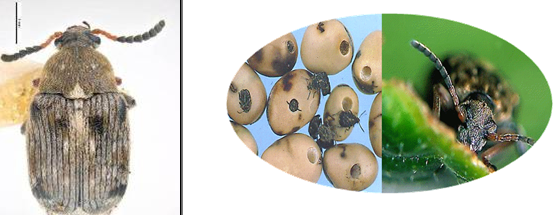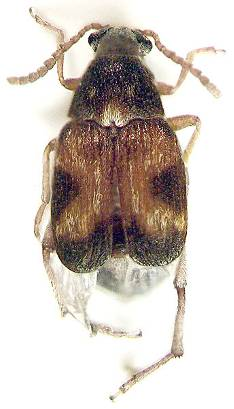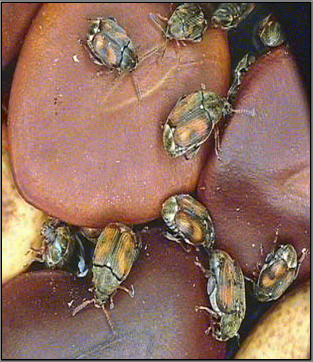Insects - faba bean
Contributors to this section: ICARDA, Syria (Siham Asaad, Abdulrahman Moukahal)
|
Contents: |
Scientific names
Bruchus rufimanus Boheman, 1833 & Bruchidius incarnatus Bohemann, 1833.
Significance
Beans may contain un-emerged pupae or adults. High levels of damage or infestation are unacceptable for export outlets for human consumption. For seed purposes, the damage may not be as serious, although germination of the seed may be slightly reduced.
Symptoms (Damage)
Damage to beans is characterized by a circular hole in the seed where the adult beetles emerge. Other types of damage such as seed staining and smaller holes may be seen where the larvae has not matured.
Hosts
Faba bean, cowpea, common bean.
Geographic distribution
Widespread in all varieties of winter and spring field beans and also broad beans.
Biology and transmission
Bruchus spp. adults emerge from hibernation in spring and after feeding on pollen and nectar lay eggs on the immature faba bean pods. The larvae bore a small round hole through the pod coat and enter the first avail able developing seed. Most of the larval development and pupation occurs in the hard seeds after harvest in the store. The mature larvae bite a hole from inside almost to the seed surface leaving only a transparent epidermal seed membrane, which are called ‘windows’. The adults remain in the seeds and only emerge through the ‘windows’ after sowing. If the seeds are not sown, but stored for another season the adults will die.
Detection/indexing method in place at the CGIAR Center at ICARDA
- Visual inspection
Treatment/control
- Since the infestation of Bruchus spp. starts in the field control methods should aim at reducing the population in the field before the larvae penetrate the seed.
-
Several cultural measures can be used to reduce Bruchus spp. infestations:
- Deep ploughing after harvest.
- Use of uninfected or treated seeds for sowing which has to be followed by all farmers to avoid immigration of the flying beetles from infested to uninfected fields.
- Storage of seeds for 2 successive seasons, so that all adults are dead at the time of sowing.
- Late sowing also reduced Bruchus spp. infestations. Because of the shorter growing period however, yields are also reduced. With regard to chemical control insecticides such as endosulfan can be applied in the field at early pod setting or harvested seeds can be fumigated with phosphine or methyl bromide. The annual routine fumigation conducted in Egypt decreased the infestation from more than 12% to less than 1%within 5 years.
- Screening of large numbers of germplasm for host plant resistance to B. incarnatus only revealed reduced infestation in the genotypes that are late in flowering and pod setting
Procedure followed at the centers in case of positive test
- Fumigation
References and further reading
http://www.inra.fr/hyppz/RAVAGEUR/6bruruf.htm
http://ressources.ciheam.org/om/pdf/a10/92605136.pdf
http://www.padil.gov.au/viewPestDiagnosticImages.aspx?id=394
 Bean Seed Beetle (photos: www.pgro.org) |
Cowpea seed beetle, Adzuki bean seed beetle
Scientific names
Callosobruchus maculatus (Fabricius), 1775, C. chinensis (L.), 1758.
Significance
The Callosobruchus beetles are principally a serious pest of stored products under hot dry conditions; complete destruction of grain and pulses may take place in a short time. In humid climates, the rates of increase of its competitors are so much greater that it has difficulty in establishing itself.
Symptoms (Damage)
The larval stage of the weevil tunnel and develop within the beans. They may consume nearly the entire bean contents. Pupation occurs in the beans and adults emerge through a round hole in the seed coat. Damage is a combination of the feeding and contamination.
Hosts
They attack several legumes in storage, chickpea (Cicer arietinum), arhar (Cajanus cajan), green gram (Vigna radiata), pea (Pisum sativum) and kidney bean (Phaseolus vulgaris) seeds. On lentil, C. chinensis is the most common.
Geographic distribution
Both species are widespread and found in all continents with subtropical or tropical conditions (USA, Mediterranean, India, and Australia).
Biology and transmission
The eggs are glued to the bean or the pod. On hatching the larvae bores into the seed where it makes a translucent 'window' in the seed before pupating. The larval and pupal stages are spent inside the bean. The adult emerges through the 'window' leaving a neat round hole. Infestations can begin in the field. Adults move to bean fields from trash beans left in sacks, harvesters, planters, or feed areas. The cowpea weevil readily attacks dried beans; thus this weevil can be a serious storage pest. Bean weevil infestations can also start in the field and may also originate from trash beans. As with the cowpea weevil, bean weevil will attack dried beans and can be a serious pest in stored beans. Broad bean weevil infestations also start in the field, but this pest is not a storage problem.
Detection/indexing method at ICARDA
- Visual inspection
Treatment/control
- Cleanliness in storage: Stores should be cleaned from all residues of grains, straw and flour and be de-infested by spraying walls with malathion, sacks, thresher and transportation vehicles also should be cleaned.
- Chemical control/protection: Seeds stored for food/feed can be fumigated with phospine (Phostoxin) available as 0.6 g pellets and 3 g tablets. The recommended dosage is 0.5-1 tablet/m3 with an exposure time of 2-4 and 3-5 days for pellets and tablets, respectively. The major advantages of Phostoxin are that it controls all insect stages, has no residues, does not affect flavor or germination and is easy to handle. Seeds stored for planting can be treated with insecticides such as Actellic at 4-10 ppm a.i. (0.5 g/kg seed) or malathion at 10 ppm a.i., which will protect the seeds for several months.
- Traditional methods of seed protection: Small quantities of seed stored for human consumption are often mixed with different vegetable oils or other substances. Mixing seeds with olive oil and salt (5 ml and 20 g/kg seed) or Neem seed oil (3 ml/kg seed) can provide adequate control for a period of 3-4 months.
Procedure followed in case of positive test
- Fumigation
References and further reading
http://www.icarda.org/Publications/Field_Guides/Lentil/Lentil.htm#Lent7.Html
http://www.infonet-biovision.org/default/ct/82/pests
http://agspsrv34.agric.wa.gov.au/Ento/pestweb/Query1_1.idc?ID=-1771861620
http://www.zin.ru/Animalia/coleoptera/rus/calmacdk.htm
http://www.uky.edu/~cfox/Students/Amarillo/Angela.html

Callosobruchus maculatus (photo: www.zin.ru/ ) |

Callosobruchus maculatus (photo:www.uky.edu/) |

Callosobruchus chinensis |
Comments
- No comments found

Leave your comments
Post comment as a guest